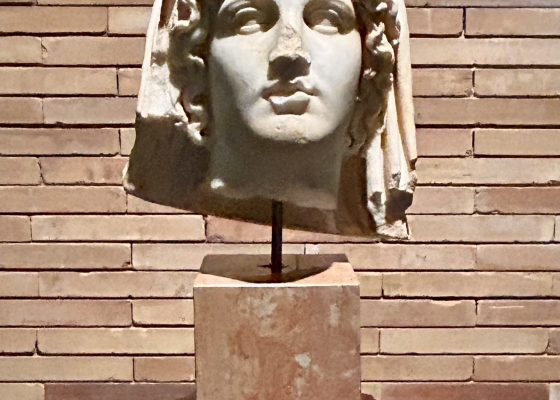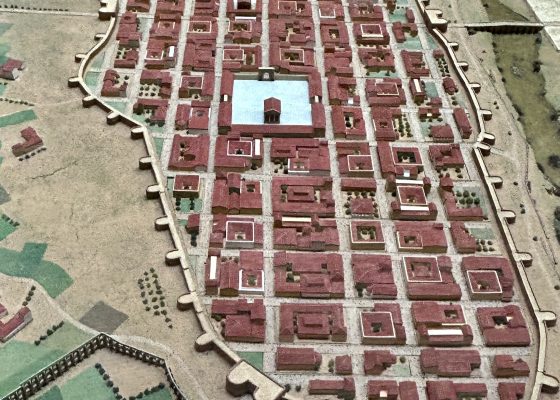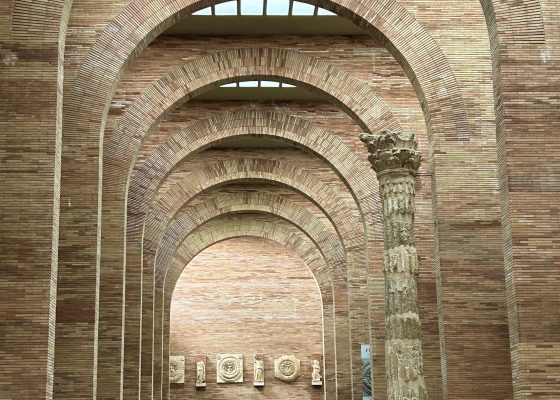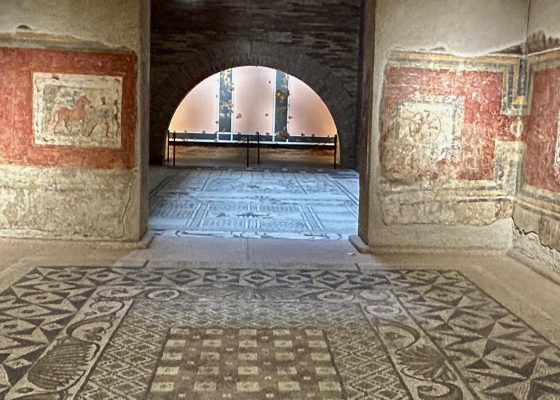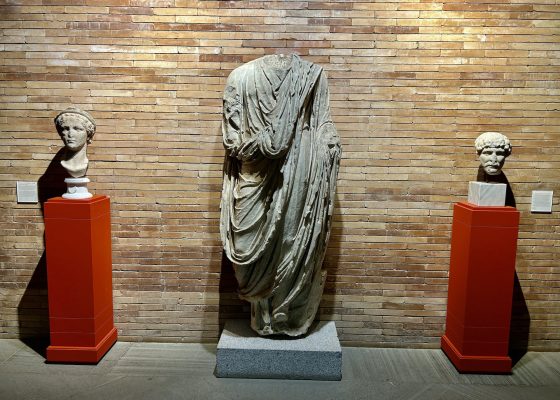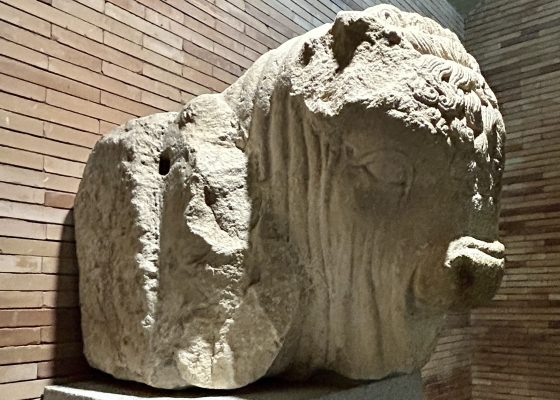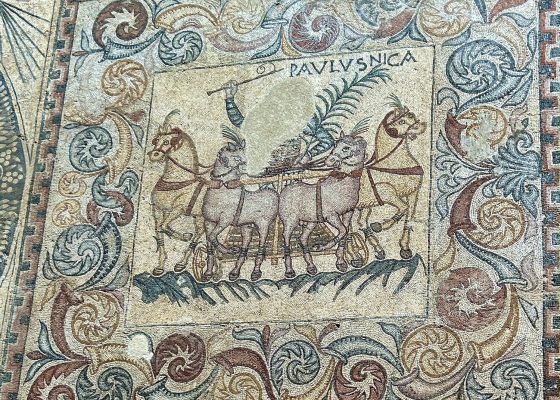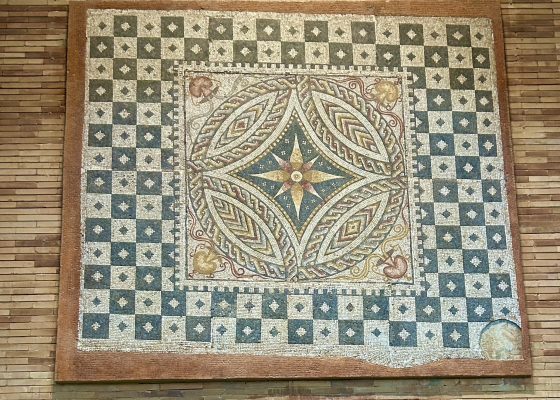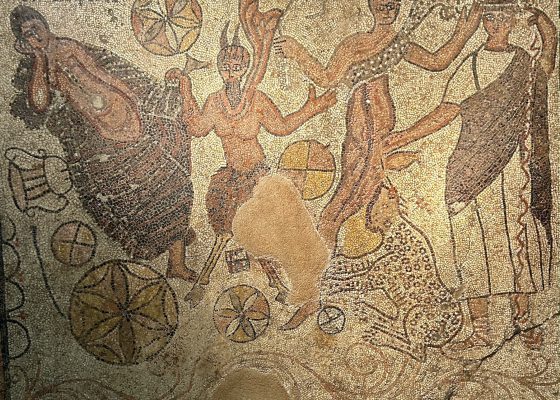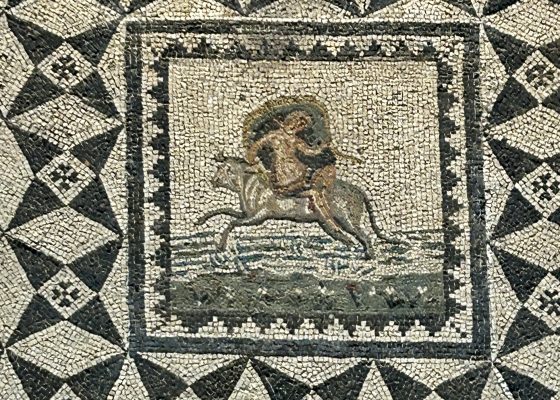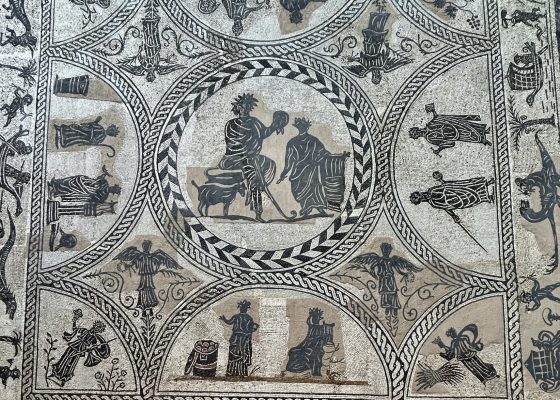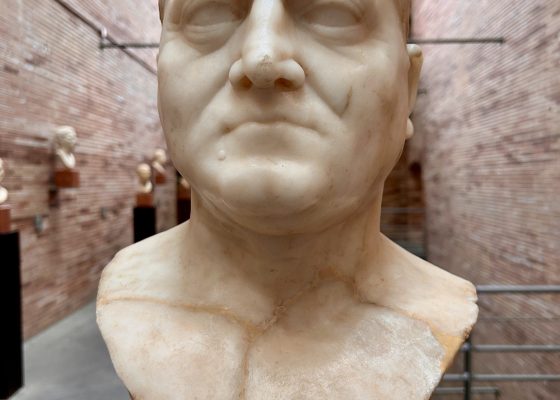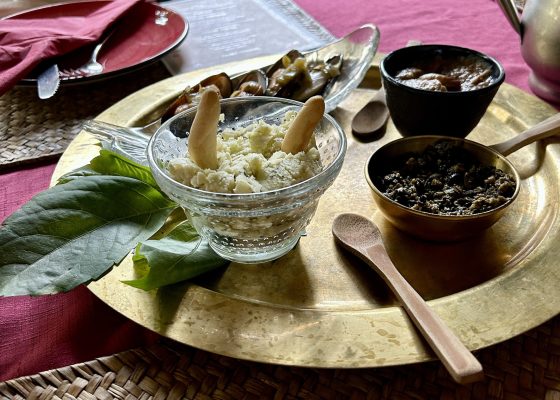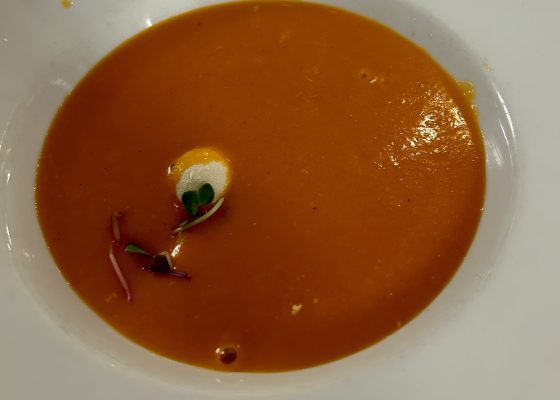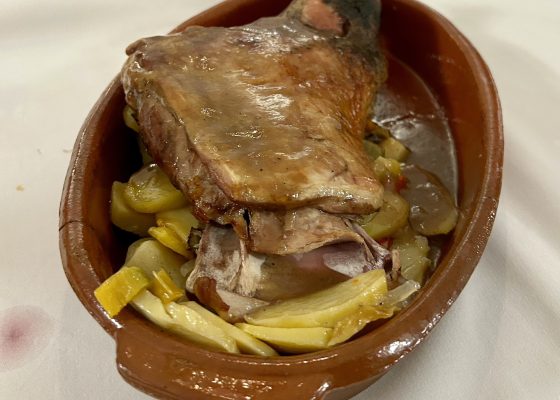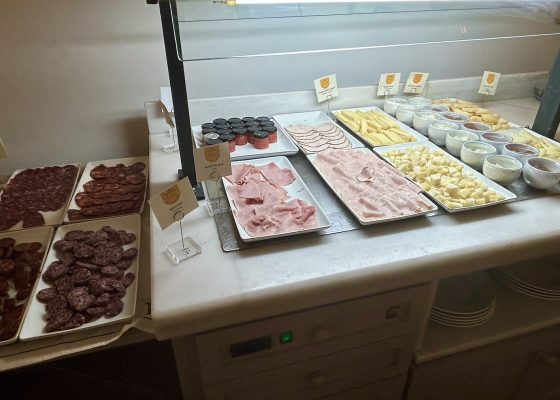Merida – Spain’s Roman City
In my first post from the Extremadura I gave seven reasons for visiting this most untouristy and interesting area of Spain. In this post I’ll focus in on one of those reasons, the Roman legacy of the city of Merida and its surrounding area. Whether its theatres, amphitheatres, hippodromes, Roman baths, villas, bridges, aqueducts, temples or triumphal arches, Merida has it all. You can even dress up as a Roman and enjoy a feast like a patrician noble. So please join me in enjoying the pleasures of exploring Roman Spain.
History of Merida
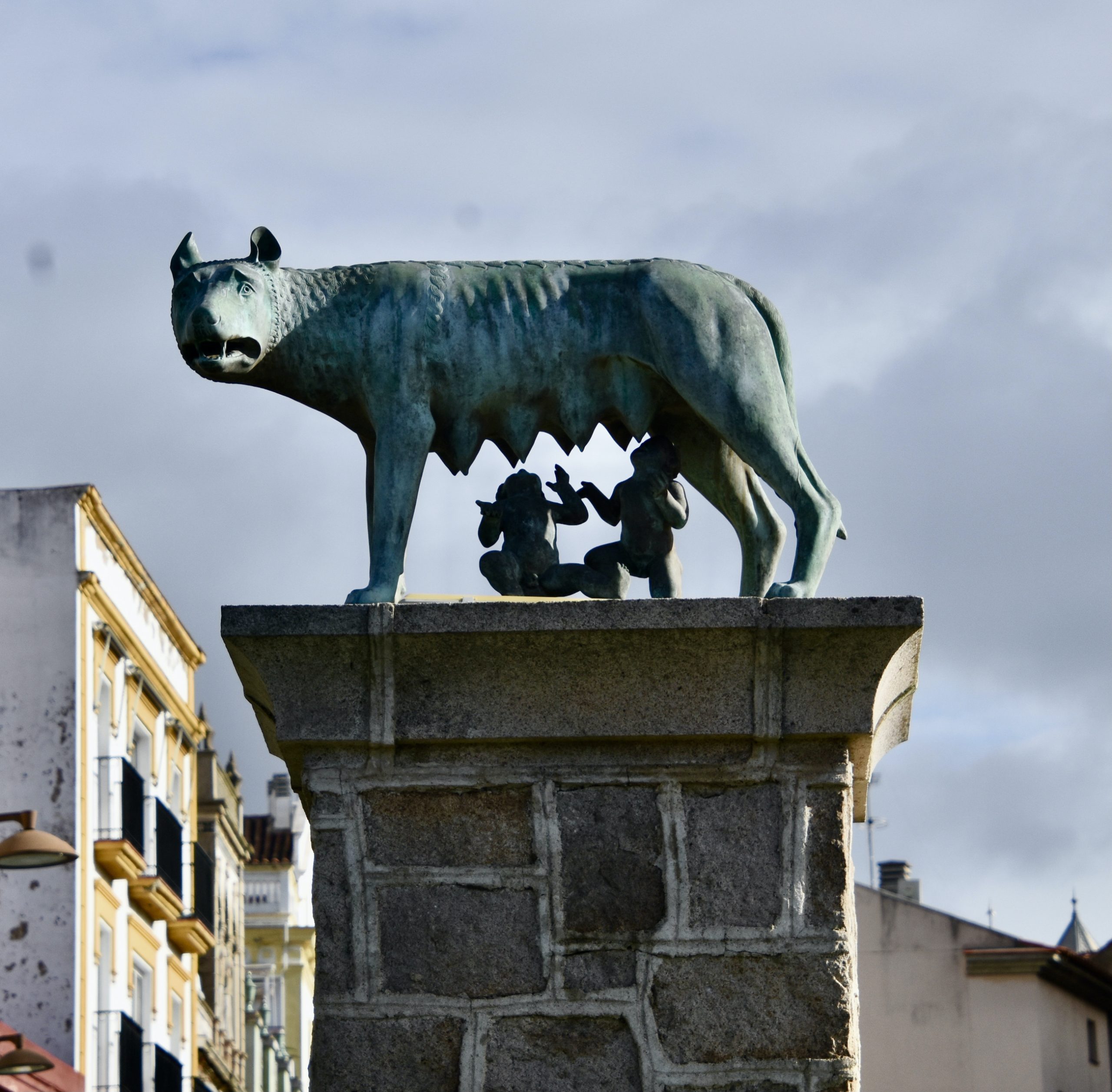
As noted in the previous post, it took the Romans a couple of hundred years to occupy the entirety of the Iberian peninsula by ousting the Carthaginians and subduing the native tribes. By 25 BCE that process was pretty well complete and the emperor Augustus had thousands of soldiers in Spain with no one left to fight. He continued what had become a very common Roman practice of granting land to retired veterans and founding a city to administer to the area of new settlement. Thus Augusta Emerita was founded in that year and went on to become one of the largest Roman cities in Iberia. The name references emerita (retired) soldiers of Augustus.
Augusta Emerita grew to a population estimated to be around 60,000 which is almost exactly what the city of Merida has today. The name Merida is actually an Arabic corruption of Emerita. The Roman city flourished until the collapse of the western Roman Empire in the 5th century. For several hundred years it was occupied by the Visigoths up until the Muslim conquest in 713. They held the city for over 500 years until it was conquered by Alfonso IX in 1230. In this post we will visit the Alcazaba a Moorish expansion of the existing Roman fortress.
What is remarkable about Merida today is that whether it was Visigoths, Muslims or Christians, the Roman origins of the city remained largely intact. In 1993 the Archaeological Ensemble of Merida was inscribed as a UNESCO World Heritage Site with this description:
The modern city of Mérida has been built on top of Emerita; yet, archaeological remains are well preserved and still evidence the Roman city. The 22 component parts of the property comprise an area of 31 ha. These include buildings for entertainment (theatre and amphitheatre), public architecture of the Forum and other spaces of power (provincial forum), engineering works (bridges, the dyke, cutwater and clean and waste water systems), and religious buildings, such as the Temple of Diana or the Temple of Marte. The property also includes excellent examples of private architecture, such as the Casa del Anfiteatro, La Casa Basílica, or Casa del Mitreo, which represent daily life. Most of the elements are located within the walled area of the Roman colony, but some are found outside its walls, such as the dams, aqueducts or thermal baths of Alange, in a natural environment and a landscape that has remained comparable to the one of Roman times.
So there’s a lot to see in Merida and we’d better get started. Even before entering the city proper you will see the first evidence of Roman engineering, the Aqueduct of Miracles, one of three that supplied the city with water and the only one with any portion left standing. It attained its name long after the Romans had disappeared from Merida and been forgotten by the local inhabitants who thought the structure was truly miraculous. It is a testament to the quality of Roman building that these fragile looking arches could remain standing for over 2,000 years.

Merida Theatre and Amphitheatre
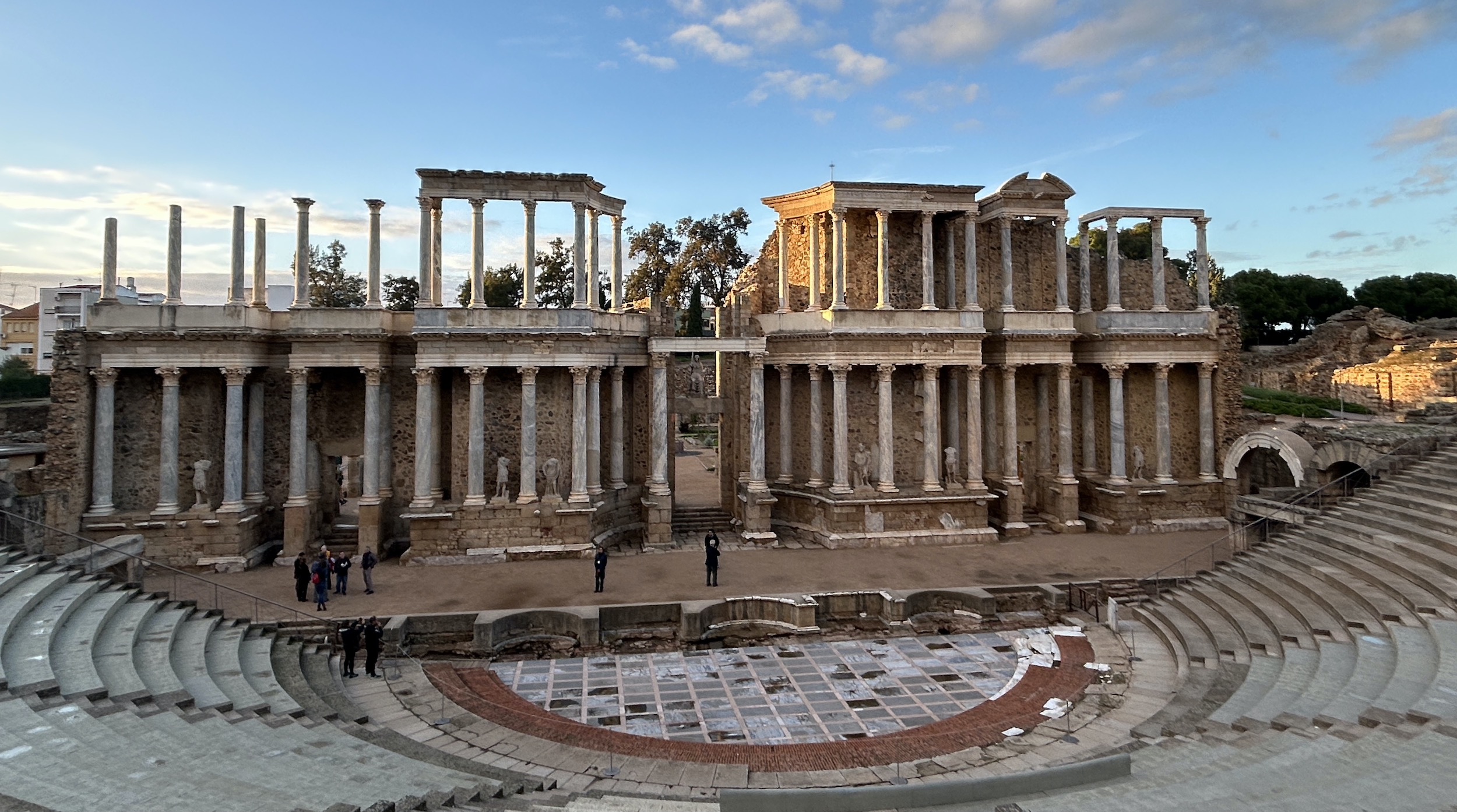
The most awe inspiring Roman ruin in Merida is unquestionably the theatre which is one of the best preserved in the world. It is one of the 12 Treasures of Spain as voted upon by the people of Spain in 2007. It was built by Agrippa, Augustus’ son-in-law in 15 and 16 BCE and could seat 6,000 patrons. Built on the side of a hill, it slowly began to fill with sediment after the Romans abandoned the city in the 5th century. Neither the Muslims or the Christians had any practical use for it until 1910 when the debris was removed and this amazingly well preserved building once again appeared in all its glory. Today it plays host to the International Festival of Classic Theatre and you can watch the same plays performed as did the Roman patrons almost 2,000 years ago.
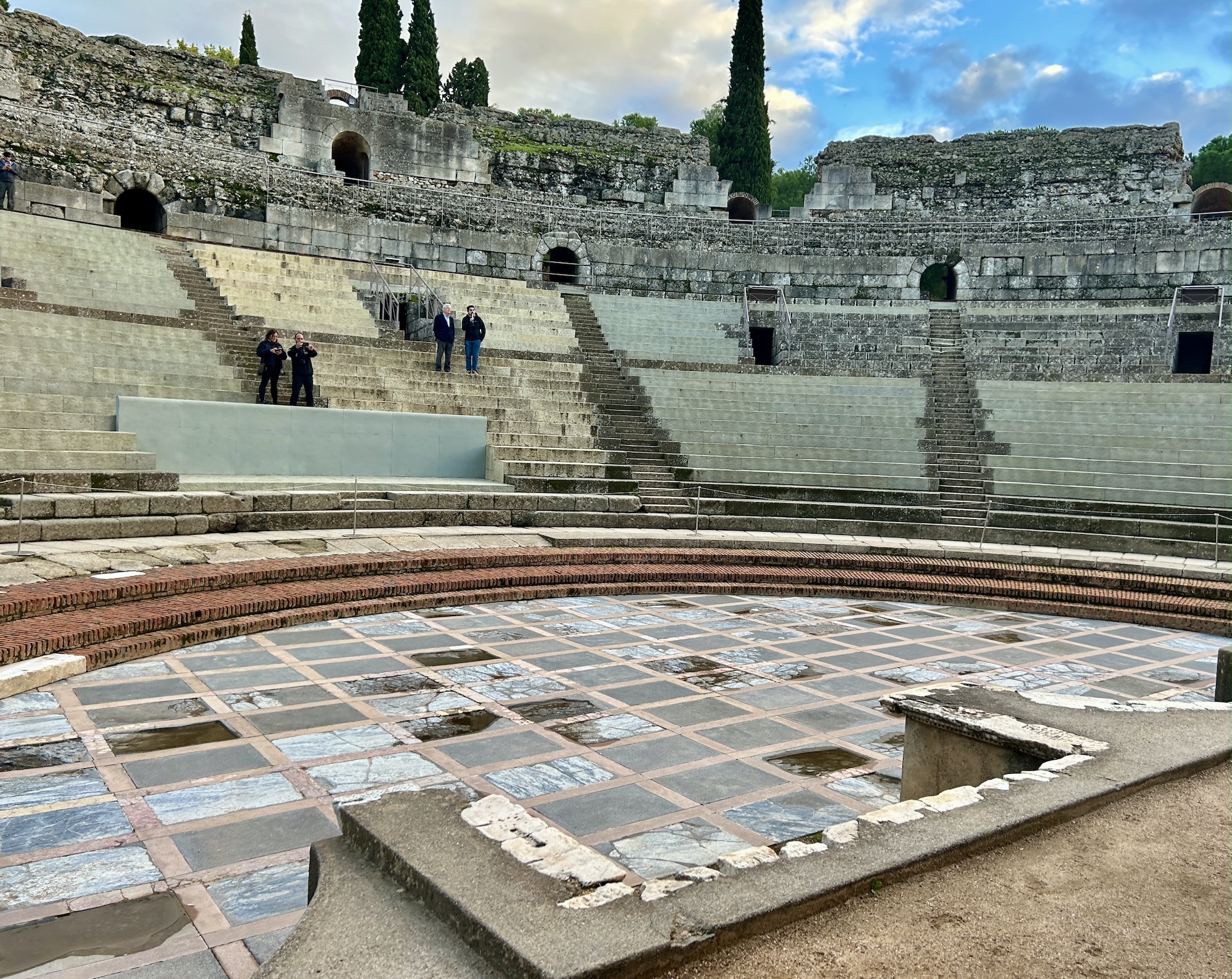
Next door to the theatre is the amphitheatre which was much larger, holding up to 16,000 spectators. Here is where the gladiatorial contests would be held pitting man against man and man against beast. In truth, the ordinary Roman citizens far preferred these type of entertainments to the hoity-toity dramas of the theatre.
This edifice is nowhere near as well preserved as the theatre, but is most impressive just for its sheer size which I could not capture in one photo. This one is from Wikipedia and shows about a third of the whole structure.
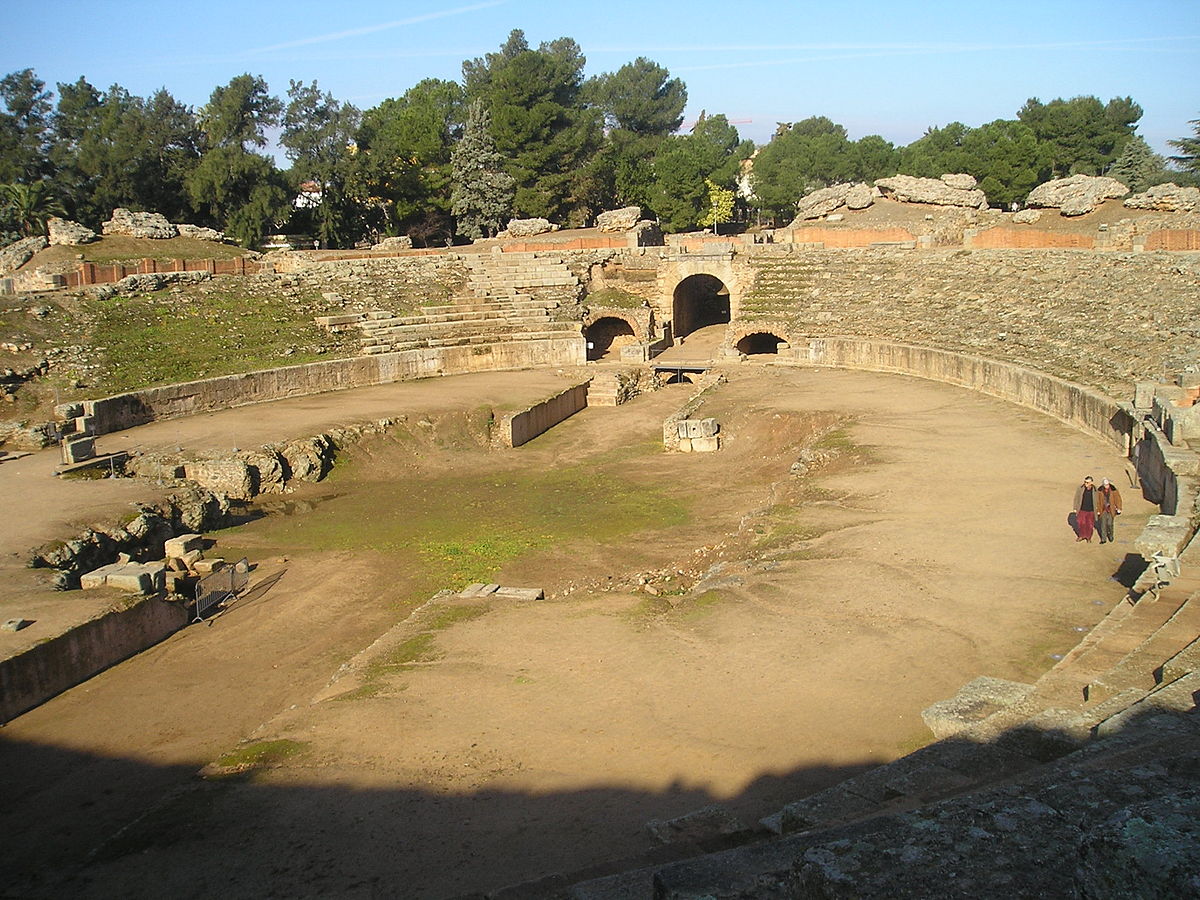
Other Roman Sites
Modern Merida is built atop the site of Augusta Emerita so that everywhere you walk signs of the ancient city pop up here and there. These are the most notable places.
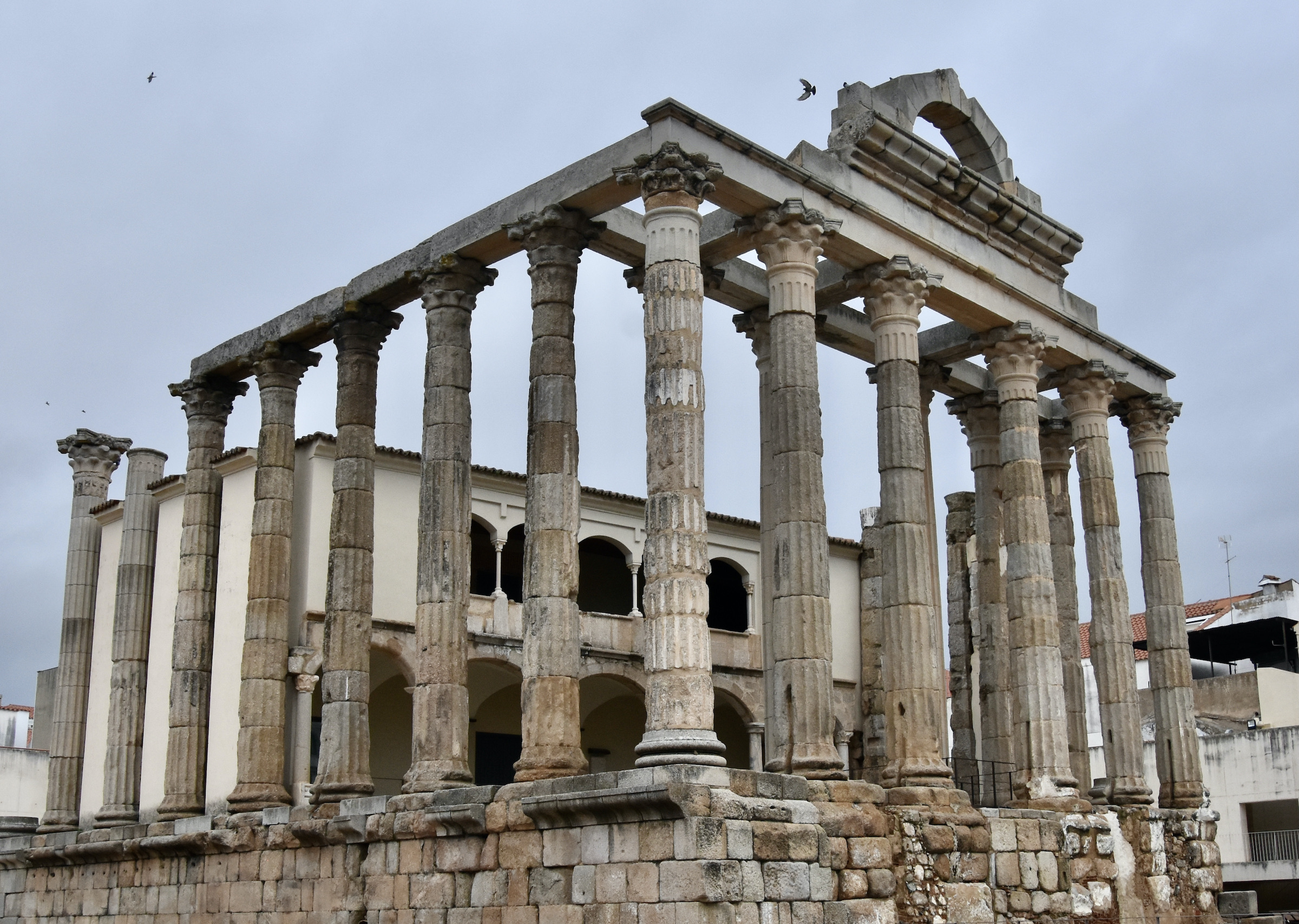
This is the misnamed Temple of Diana which was built in the first century and stood near the centre of what was the city’s forum, the heartbeat of any Roman city. As our Merida guide Antonio Cancha explained it was dedicated to the ‘imperial cult’, a concept of worshipping emperors as gods which first came into fashion in Rome under Augustus. This temple was built by his adopted son and successor Tiberius. It is pretty amazing to be walking down a fairly ordinary street and come across this edifice which jolts you back to the past in a sort of reverse sensation of coming to your senses.
If that isn’t enough then these two medallions next to it should do the trick. On the left is Medusa and on the right Jupiter Ammon Clypeus, the supreme god of the Romans who also incorporates the Egyptian deity Amon Ra. So in this area you have a temple dedicated to a living god, a mythical symbol of evil meant to deter other evils and a Romano-Egyptian god. Get your head around that.
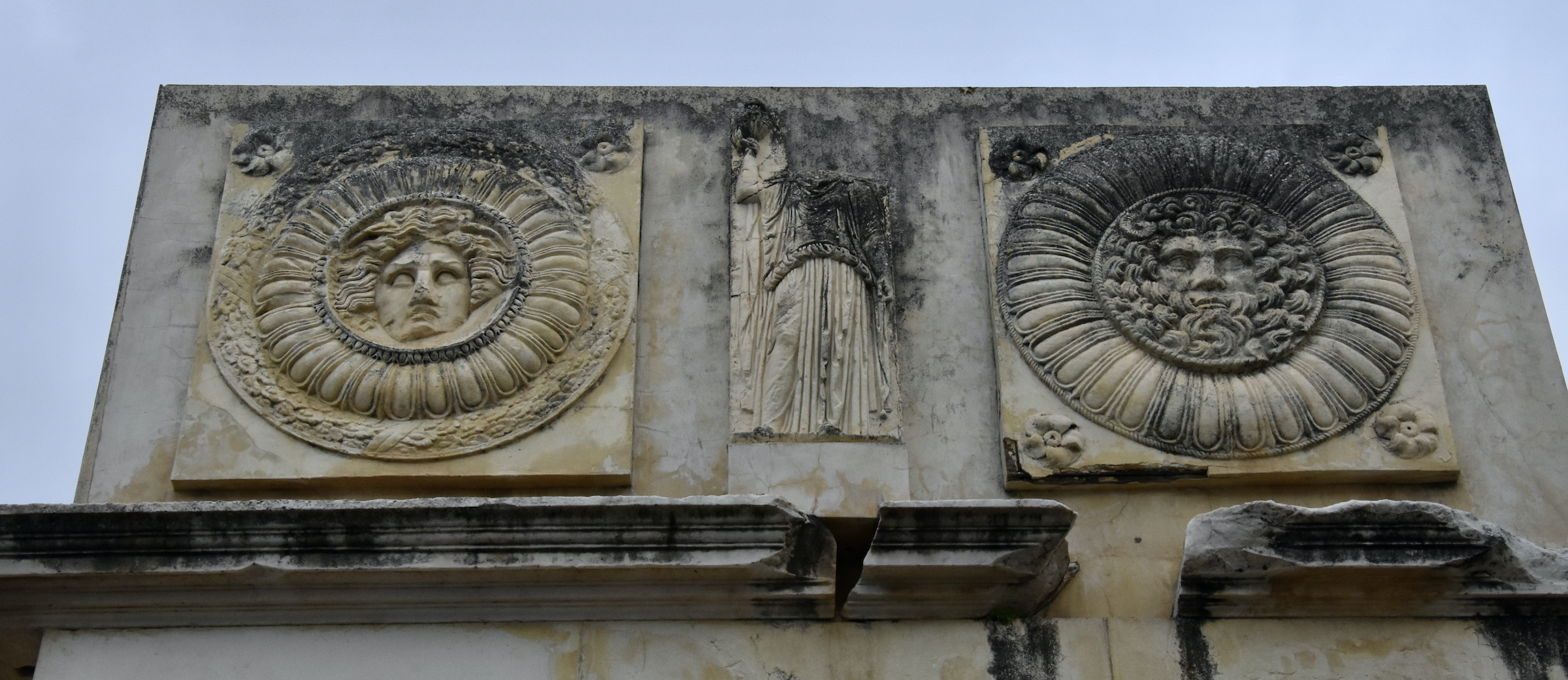
Nearby is the Arch of Trajan, one of Rome’s greatest emperors who was born in the city of Italica near the present day city of Seville. This is not a triumphal arch commemorating some great Roman feat, but simply the entrance to the forum and the sacred temples within. It was once covered in marble and would have gleamed in the sunlight, but it’s still pretty impressive.
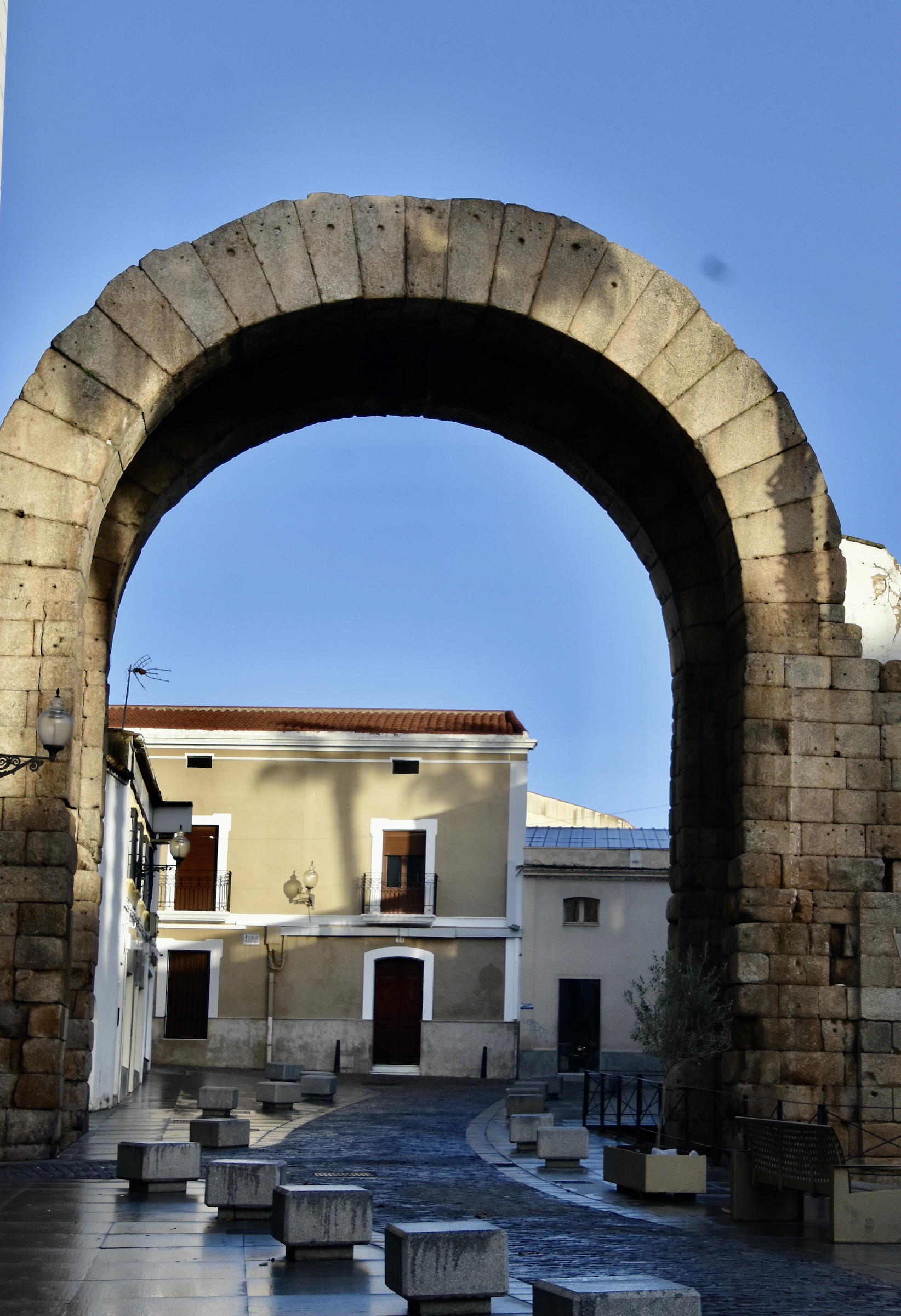
A stroll a little further on will take you to the ruins of the Casa del Mitreo a massive villa that was built just outside the ancient city walls by a Roman governor.
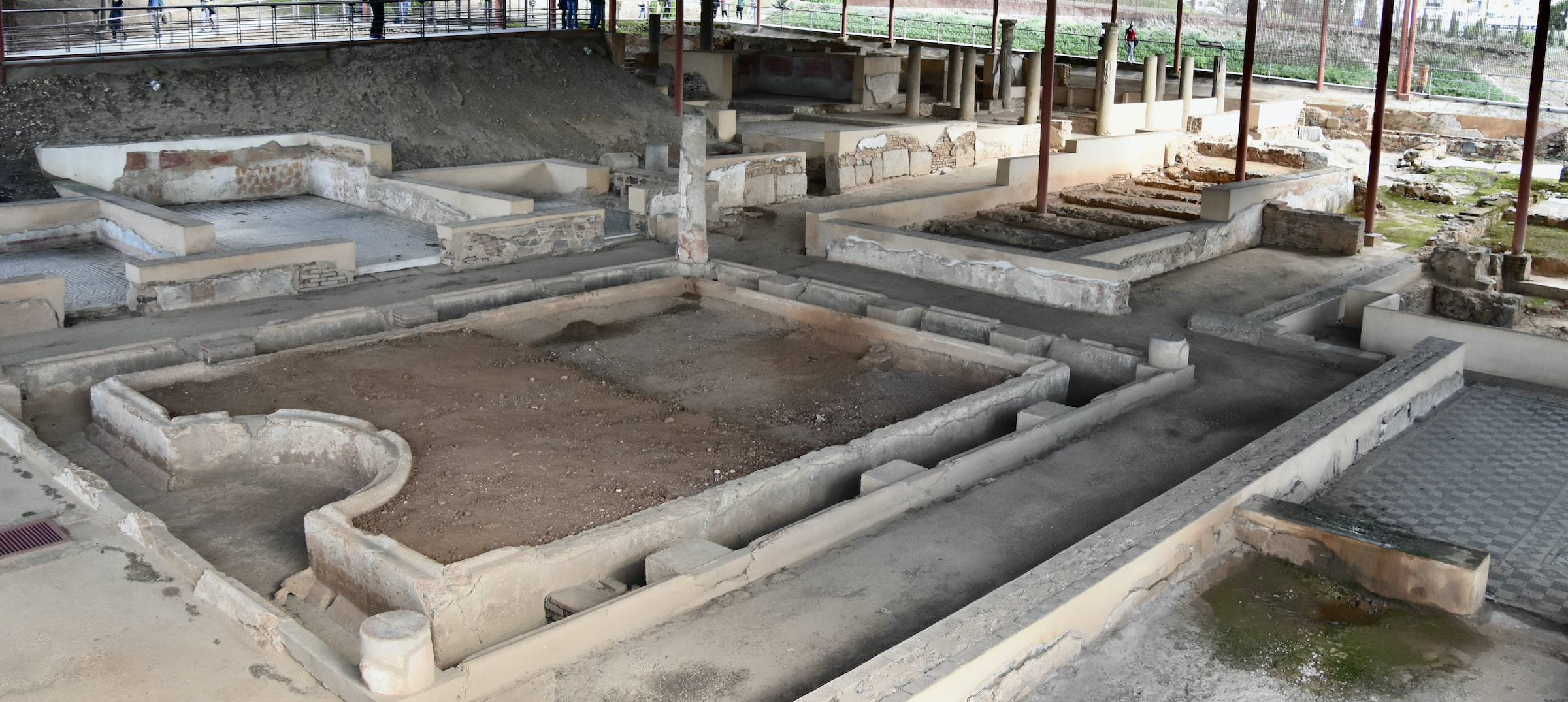
Its most impressive feature is this partial mosaic depicting the entire cosmos. Trust me it’s more interesting to see than this photo lets on, particularly the majestic figure of Oceanus in the lower left. We will be seeing a lot more mosaics from Roman Merida when we get to the museum.
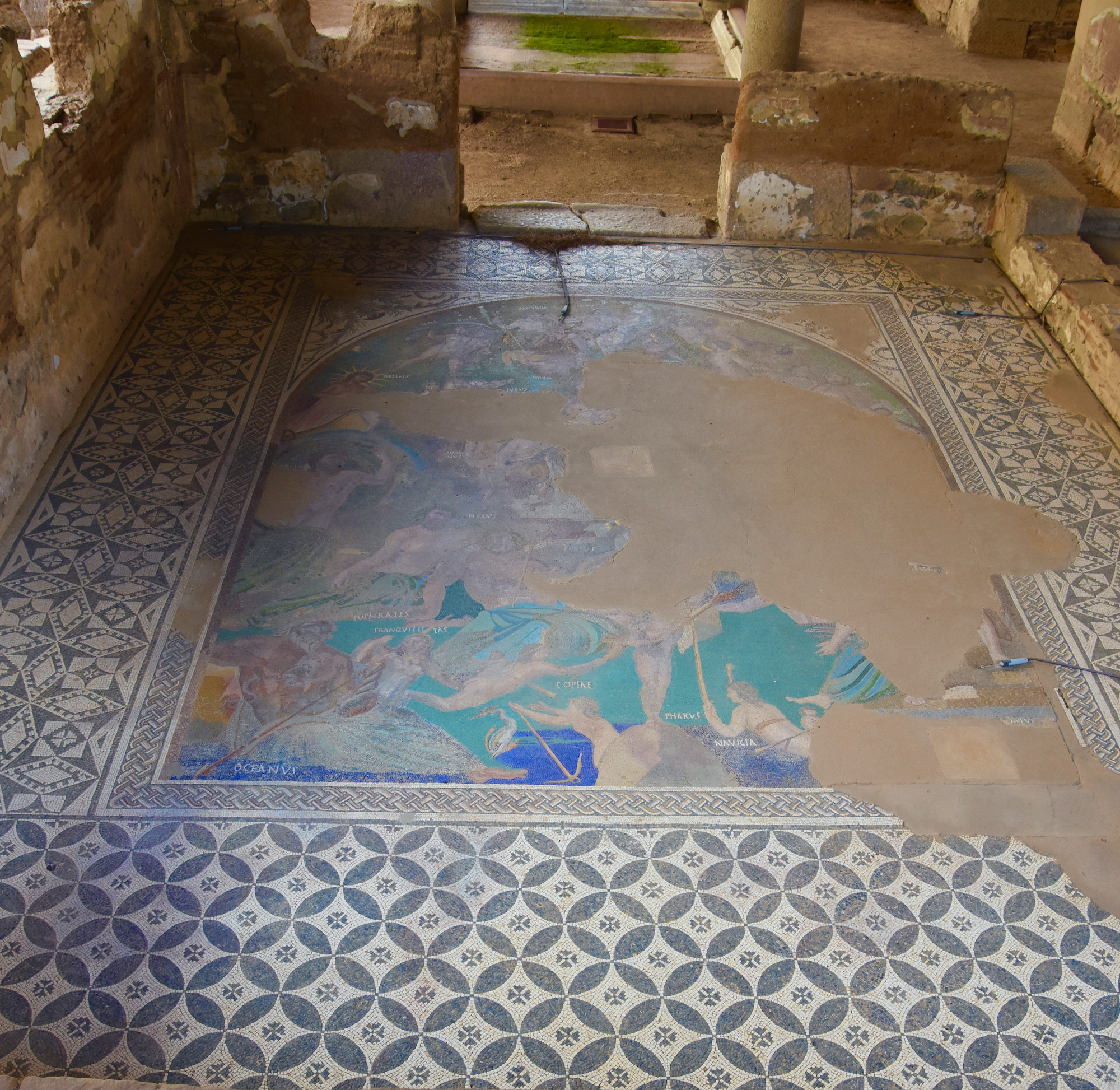
The Roman Bridge and Alcazaba
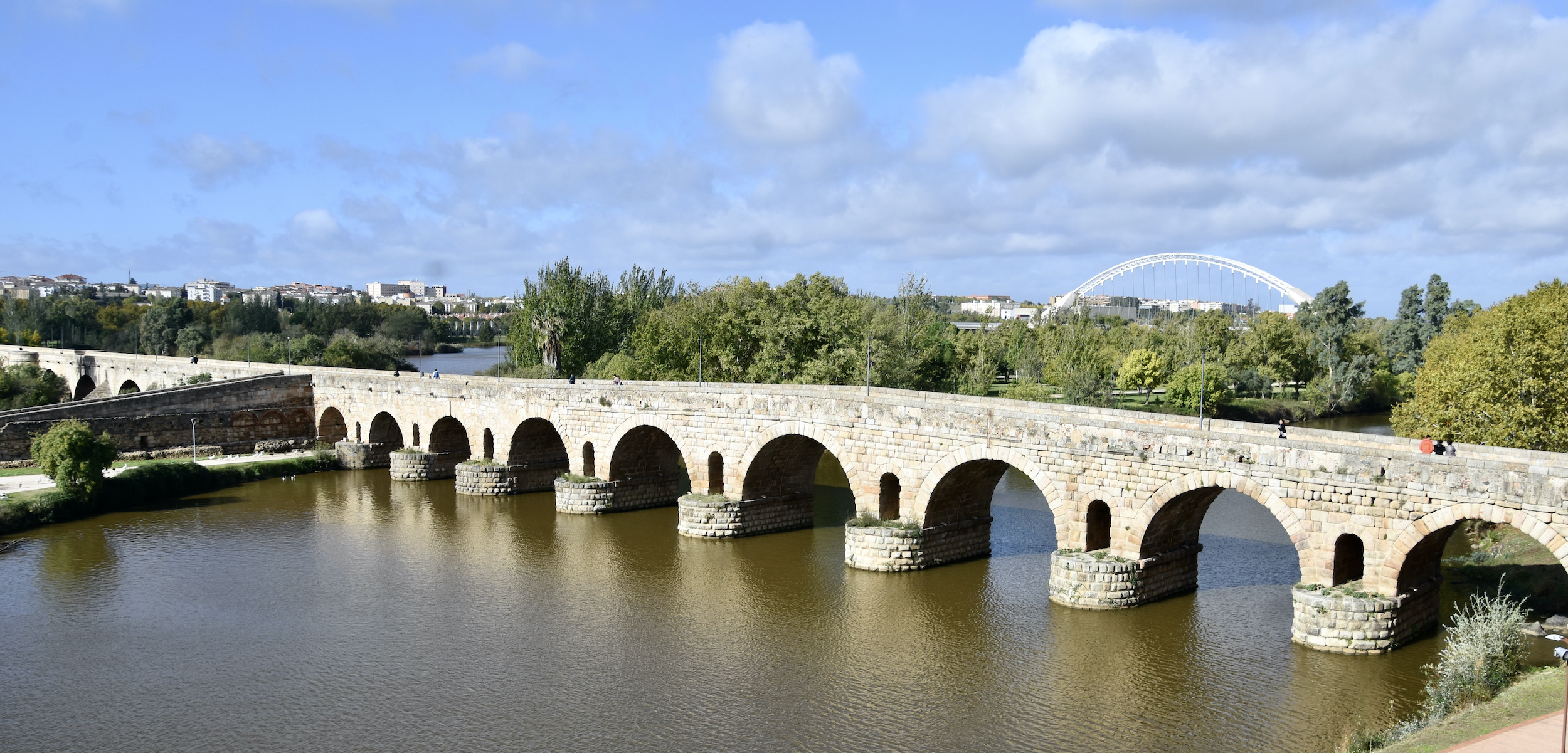
While all you can do with the structures I’ve listed so far is basically look at them, the Roman bridge across the Guardiana River is something else. It is the longest remaining ancient bridge in the world. Incredibly it was still being used by vehicular traffic up until 1991. Since then it has been pedestrianized and if there is one thing you must do in Merida it is to walk across this bridge as do thousands of Meridians do every day.
This is a view of the Guadiana River from the middle of the bridge in the early morning.
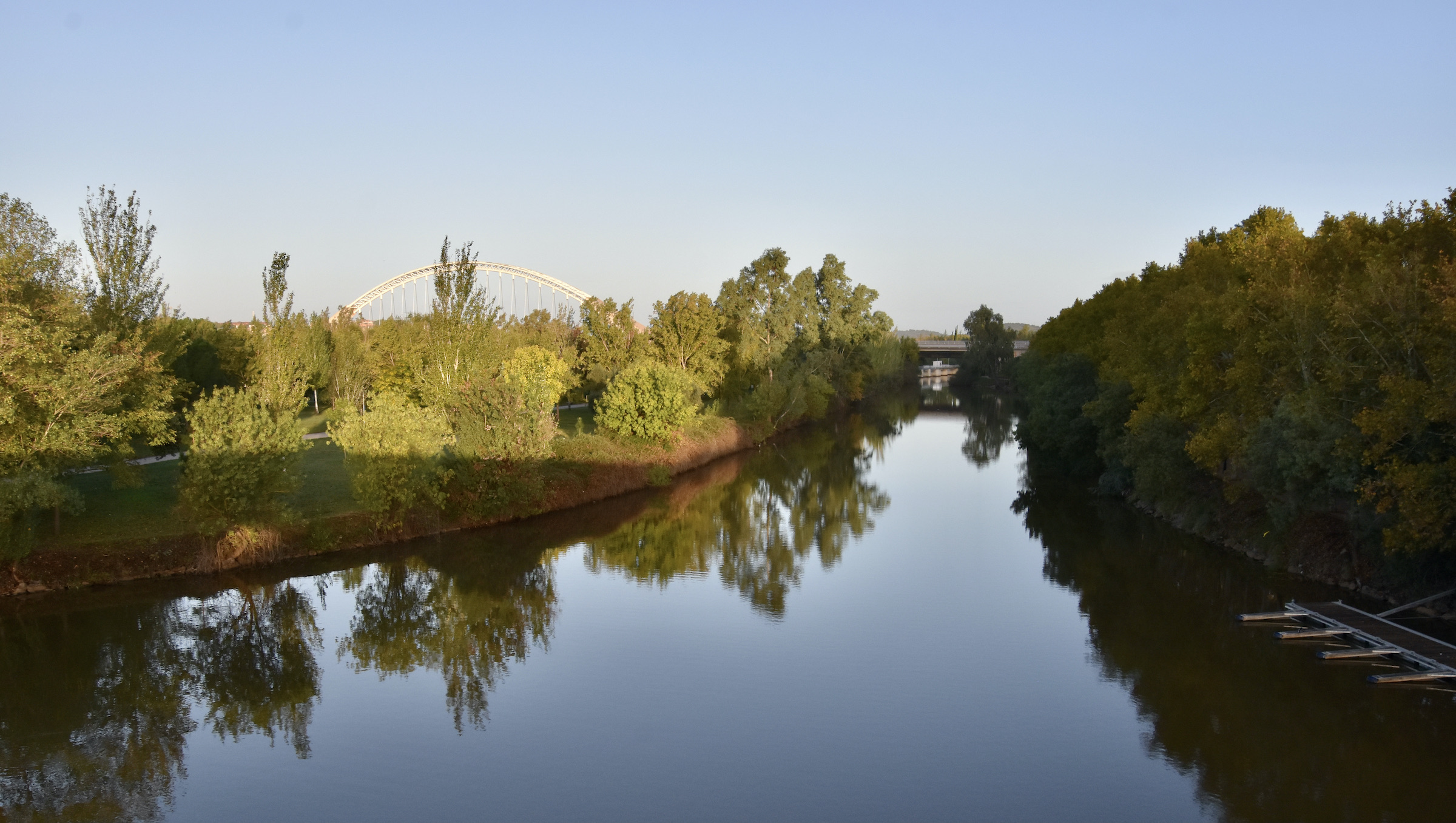
The crossing of the Guadiana on the Roman bridge is an important point on the Via de la Plata pilgrimage route to Santiago de Compostela which starts in Seville and runs through Merida following the course of an old Roman road. Most people only think of the pilgrimage route from France to Santiago, but there are actually eleven distinct pilgrimage routes to the place where St. James the Apostle is supposedly buried. All are marked by the traditional scallop shell of the pilgrim such as on this marker at the end of the bridge.
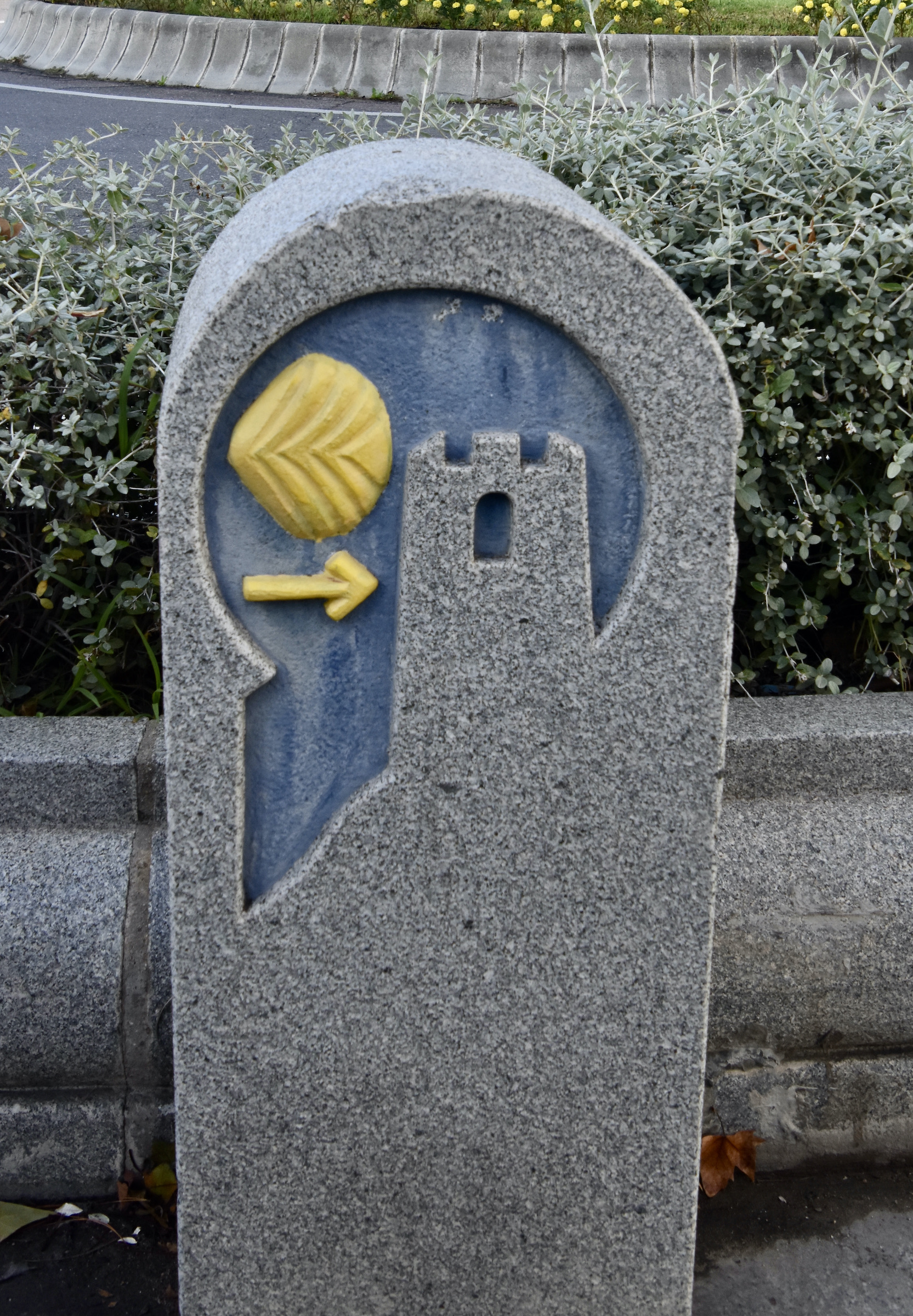
When you return to Merida while recrossing the bridge you will be at the entrance to the Alcazaba which is worth a visit. My photo of the bridge was taken from the walls of the Alcazaba. It was built in the 9th century as the administrative and defensive centre of the Umayyad conquerors of this area of Spain. The location was chosen so that traffic across the Roman bridge could be controlled.
The most interesting feature other than the view from the walls is the well which was located far below ground level and guaranteed access to the waters of the Guadiana River at all times. The Umayyads fought off many Christian revolts over the 500 + years they ruled Merida, but in 1230 they finally succumbed to the army of King Alfonso IX of Leon leaving the city with its modern name, the Alcazaba and little else.
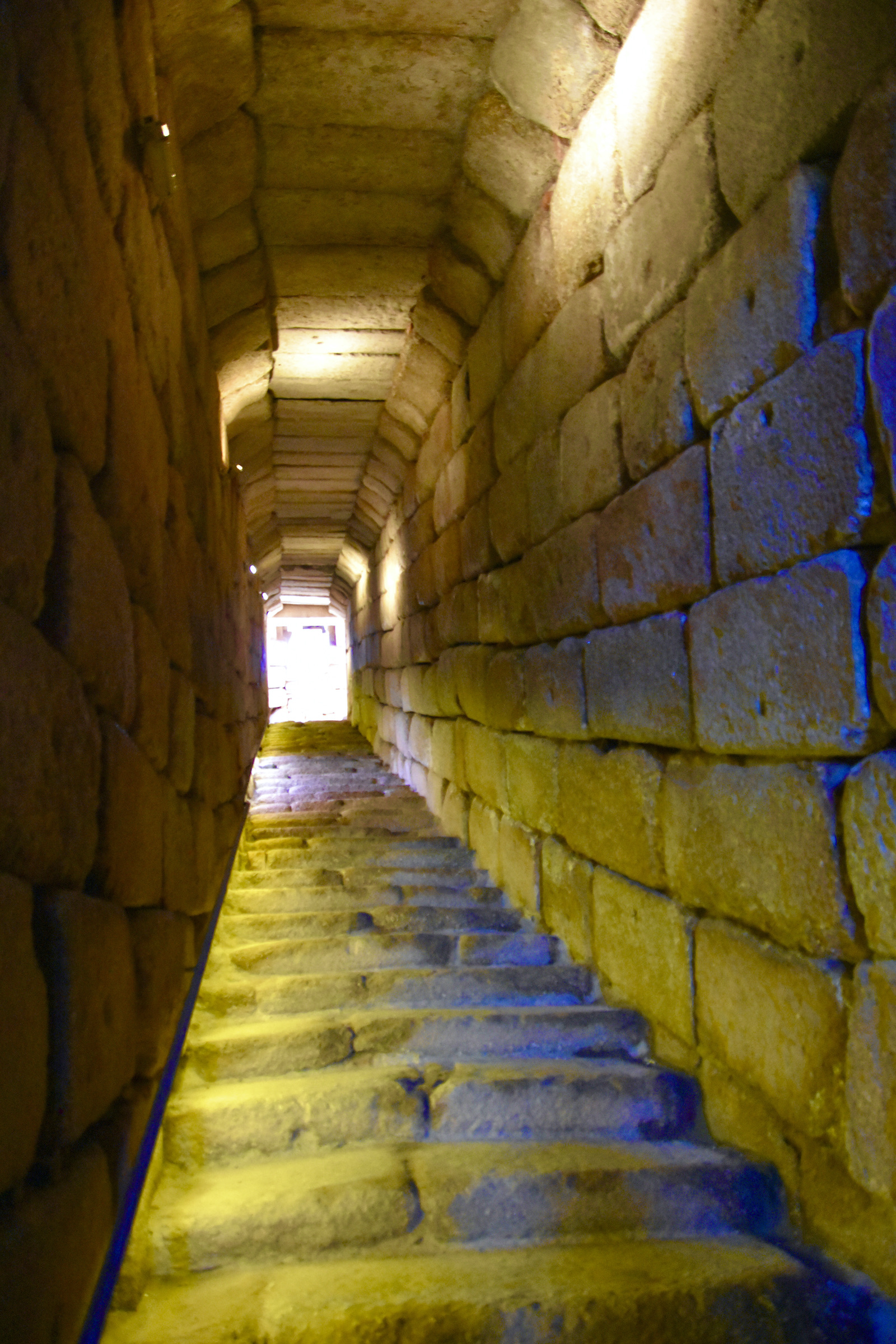
National Museum of Roman Art
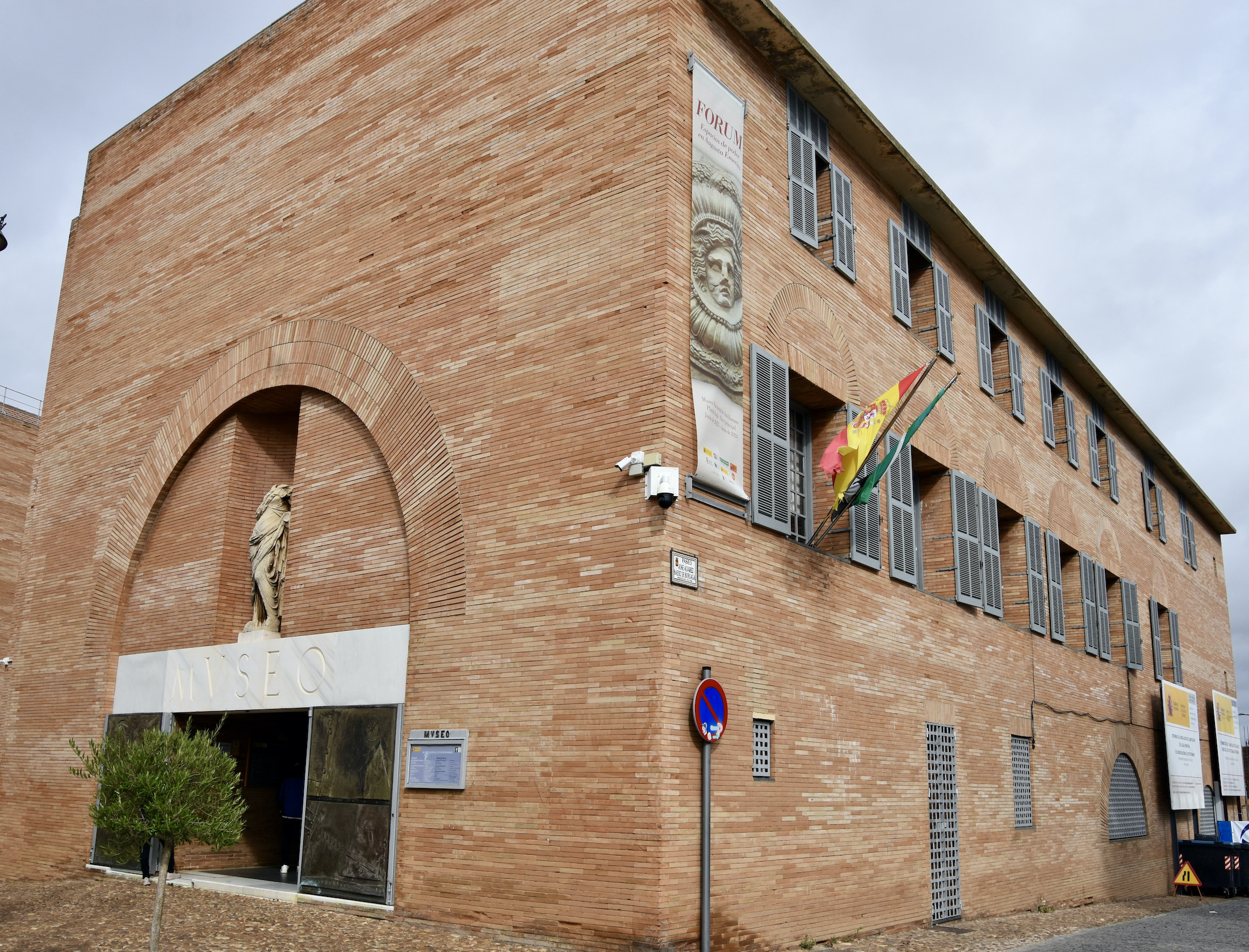
If you haven’t got your Roman Empire fix by now you can really amp it up by spending a few hours at the outstanding National Museum of Roman Art in the heart of Merida just a few steps from the amphitheatre. I could do any entire post just focusing on the great objects on display here, particularly the mosaics. However, you’ll have to settle for this gallery instead. Double click on an image to open and double click again to enlarge.
- Bust of Augustus
- Model of Augustus Emerita
- Grand Hallway
- Interior of a Roman House
- Two Heads, One Body
- Head of a Bull
- Charioteer Mosaic
- Mosaic frm villa Las Tiendas
- Naive Bacchanalia
- Rape of Europa Detail
- Scenes from the Nile Mosaic
- Realistic Bust
What if you want to do more than just look at Roman architecture and art? What if you want to experience life as a Roman? Well, there are two places you can do this near Merida.
First is the thermal spa at Alange just outside the city. This is on the same site as a Roman bath that existed since at least the 2nd century and you can bathe in the same waters that the emperor Trajan might have
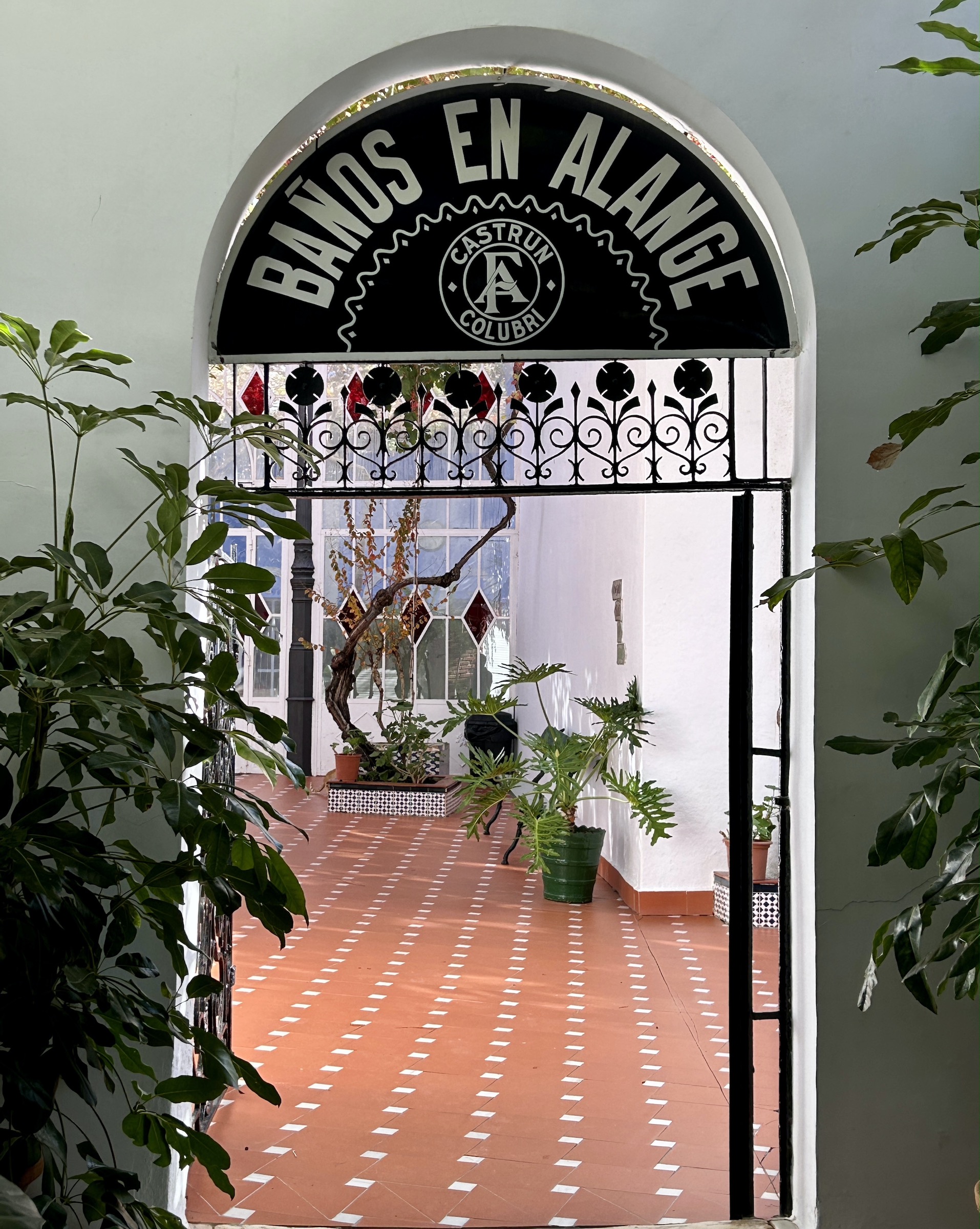
Before enjoying the modern bath take time to descend these stairs to visit the original baths on this site.
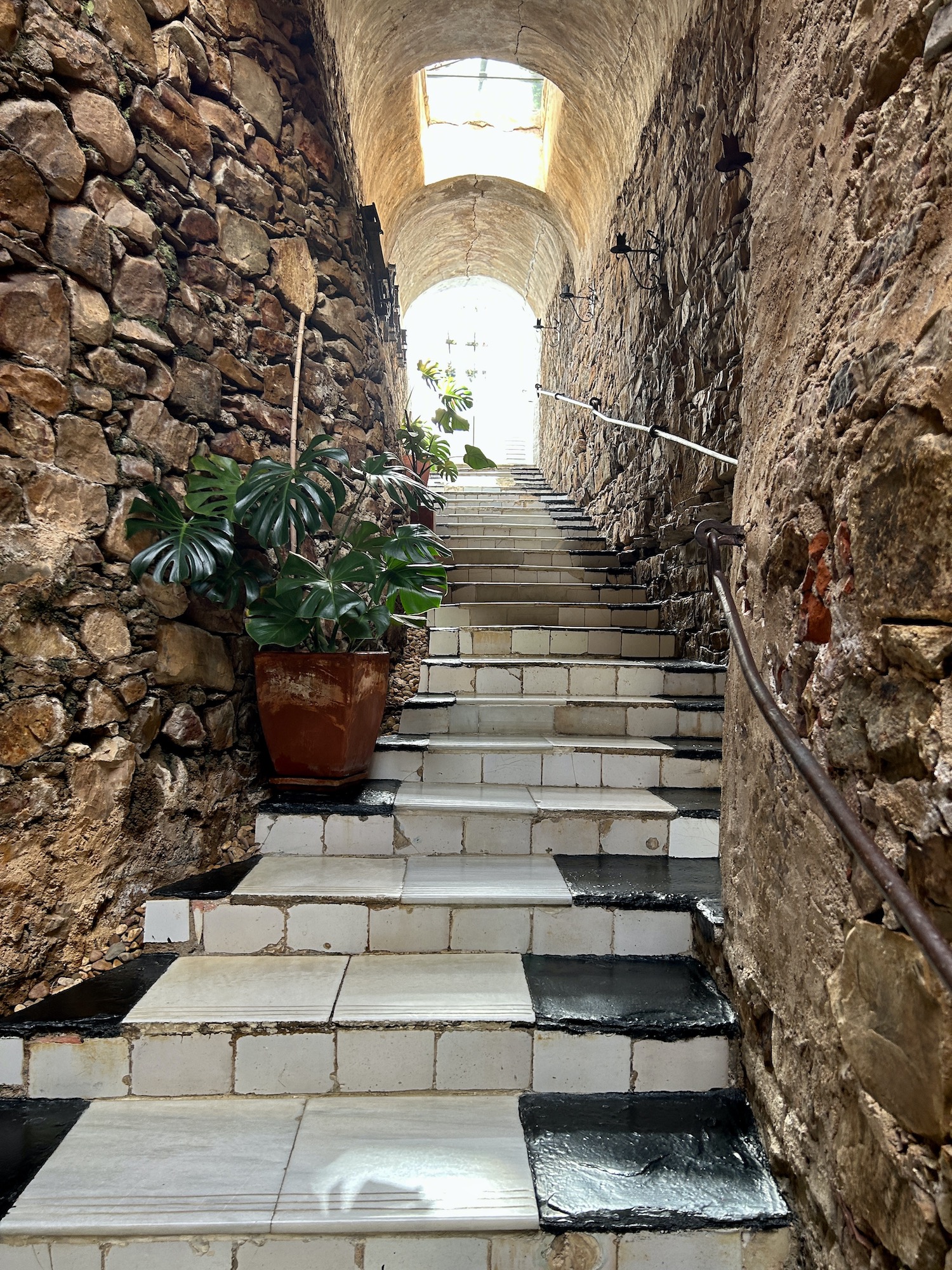
Then start off by getting your skin prepped by way of a hot and cold hosing down in what is referred to as a Scottish shower.
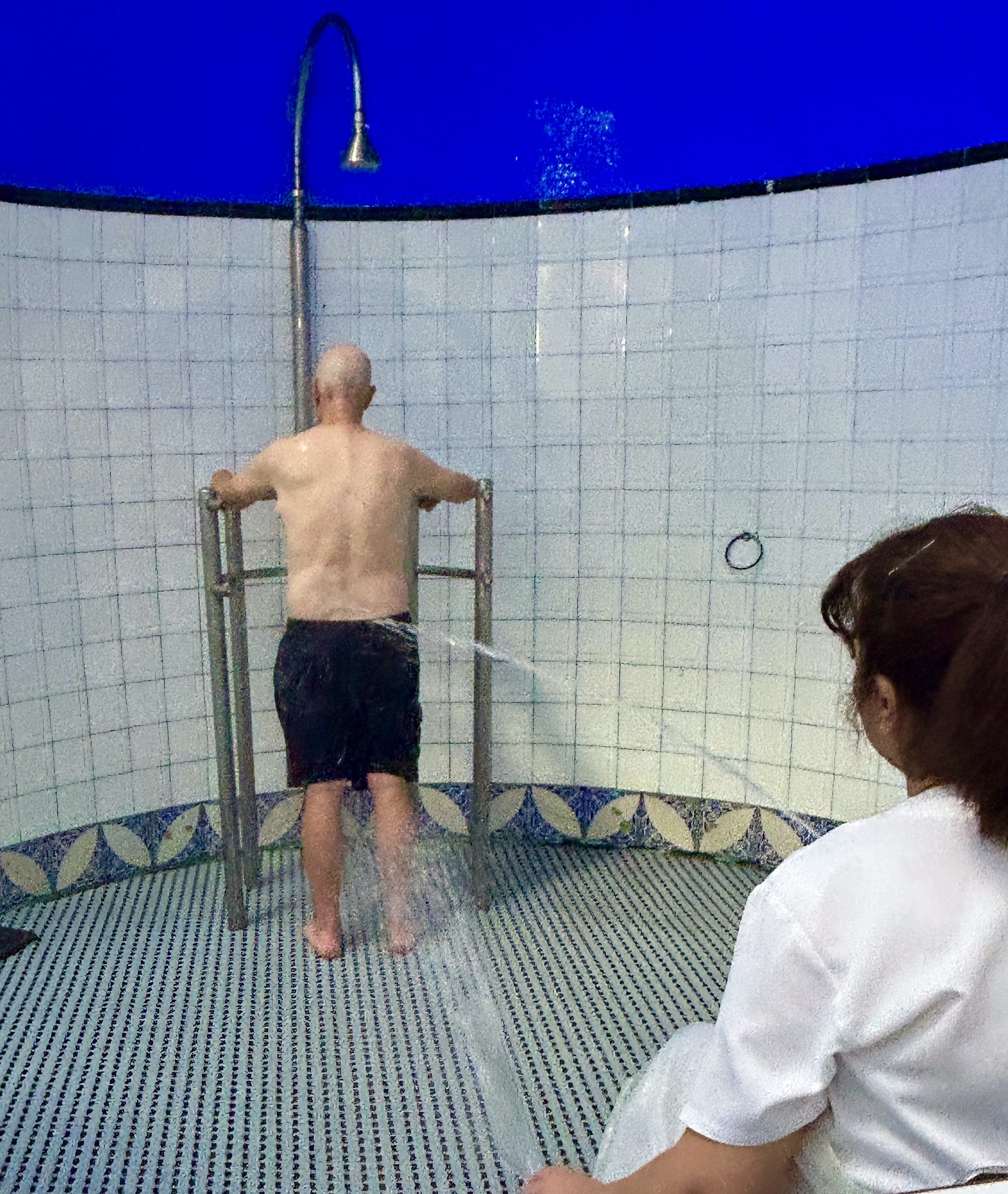
Then relax in the warm, but not too hot waters of the circular baths with the water coming from the same source as the original baths almost 2,000 years ago.
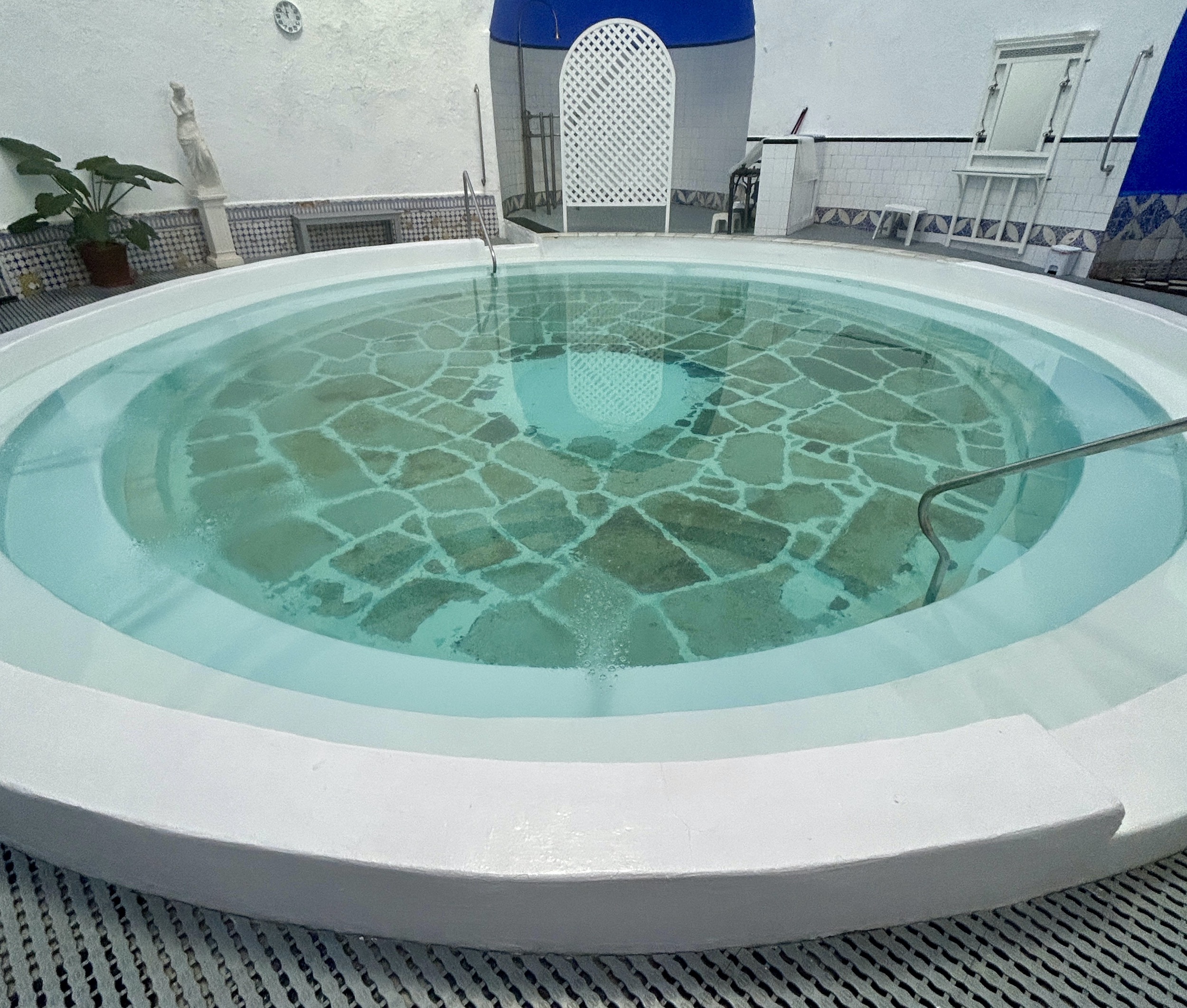
You can also indulge in more modern pleasures at the Alange facility including paraffin treatments or breathe in pure oxygen for a few minutes, both of which I tried. I won’t scare you with a selfie of me wearing an oxygen mask.
Even more authentic than visiting a Roman bath is dressing up like a Roman patrician and enjoying a feast based on a menu that goes back to the days when Augusta Emerita was in its glory. You can do this Aqua Libera in the small village of Aljucen less than 15 kms.(9.3 miles) north of Merida. The owners have recreated a small Roman villa setting complete with temple and bath.
First you done your toga and laurel wreath.
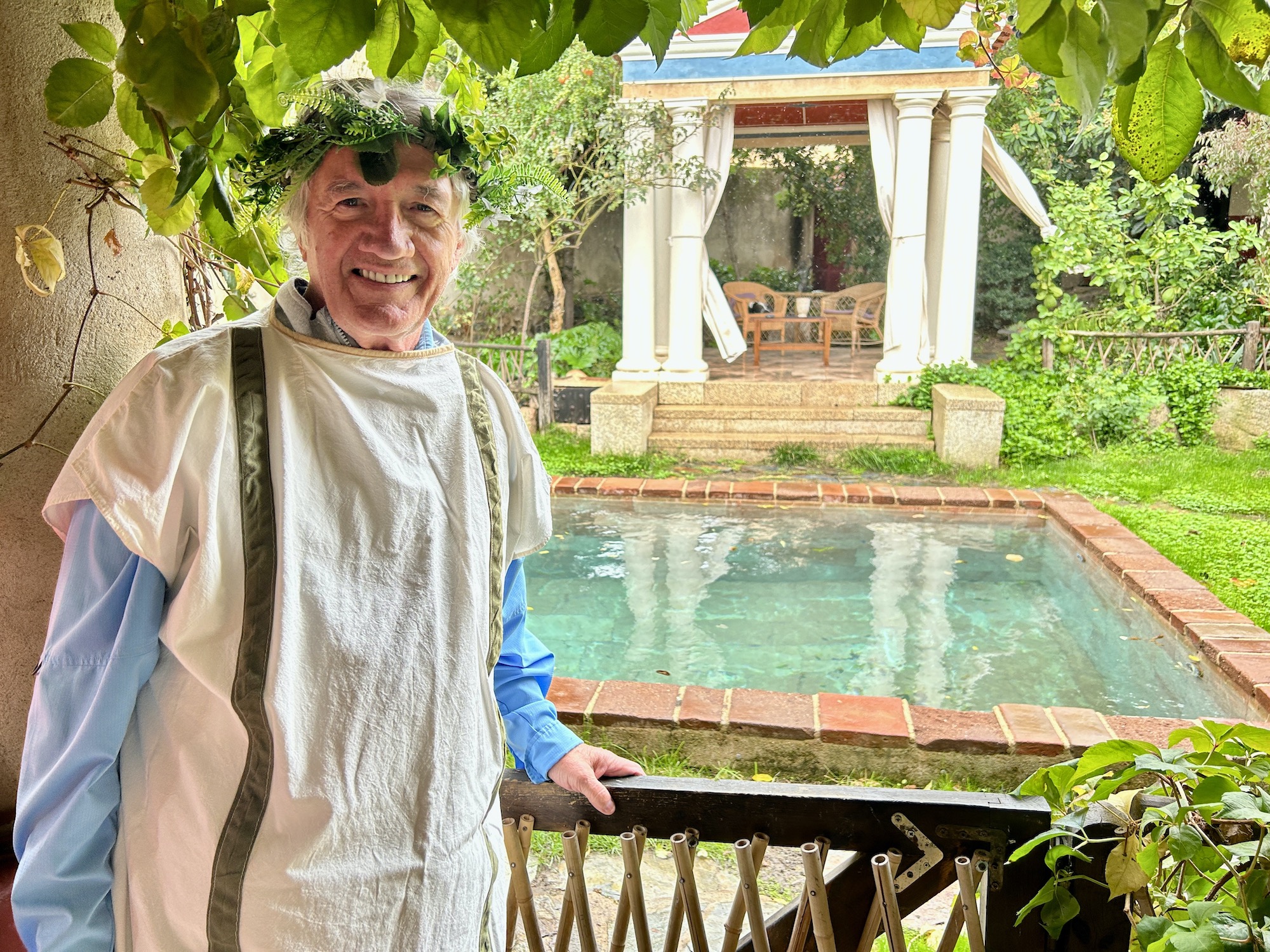
Then you dig into a series of courses based on ancient Roman dishes washing it down with watered down wine as did the Romans. You’d be surprised how quickly you become used to it.
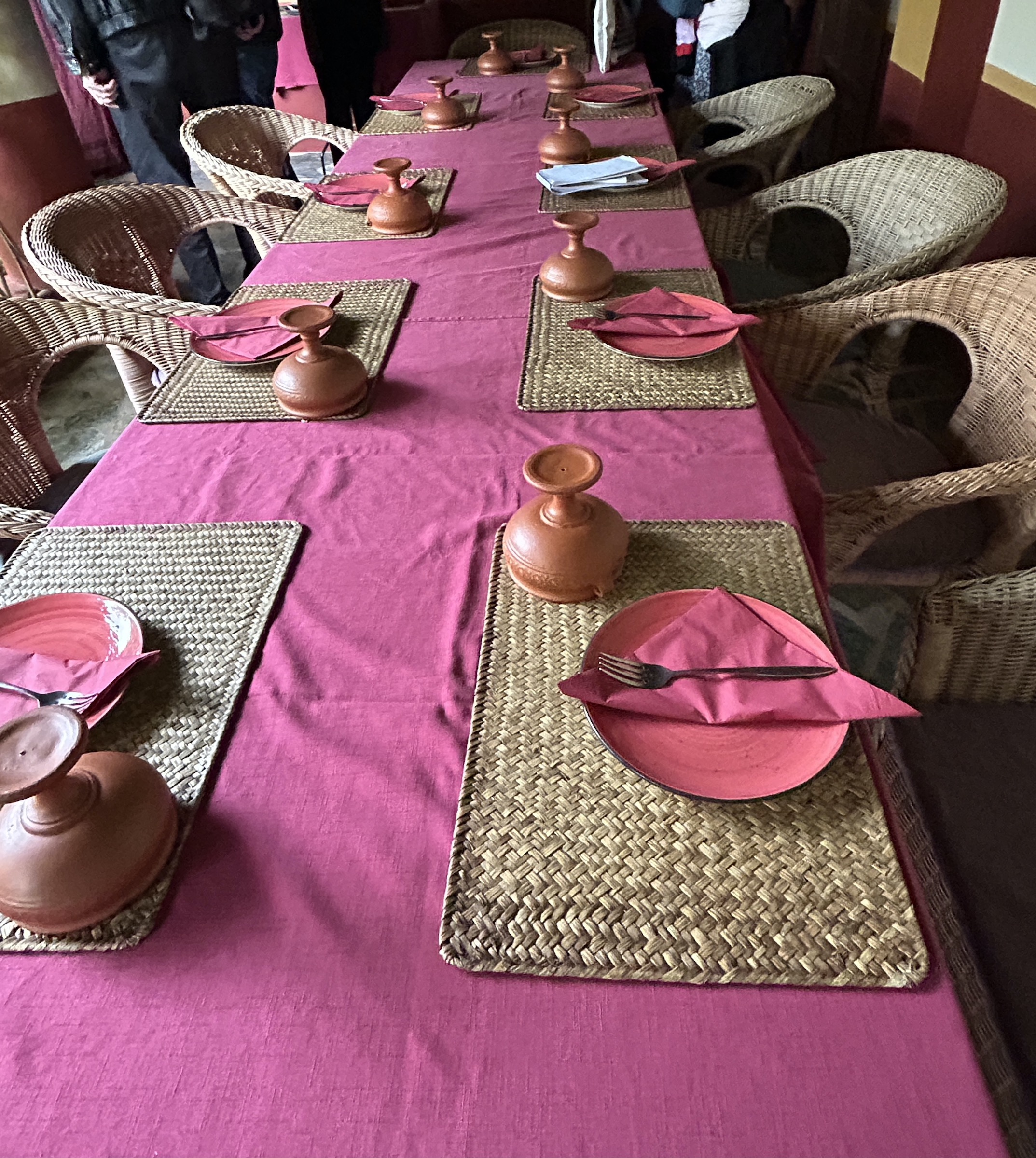
Here is a small gallery of our dishes at Aqua Libera.
- Appetizers
- Seared Tuna
- Pork Cheek in Apericius Sauce
- Desserts
Merida Paradore
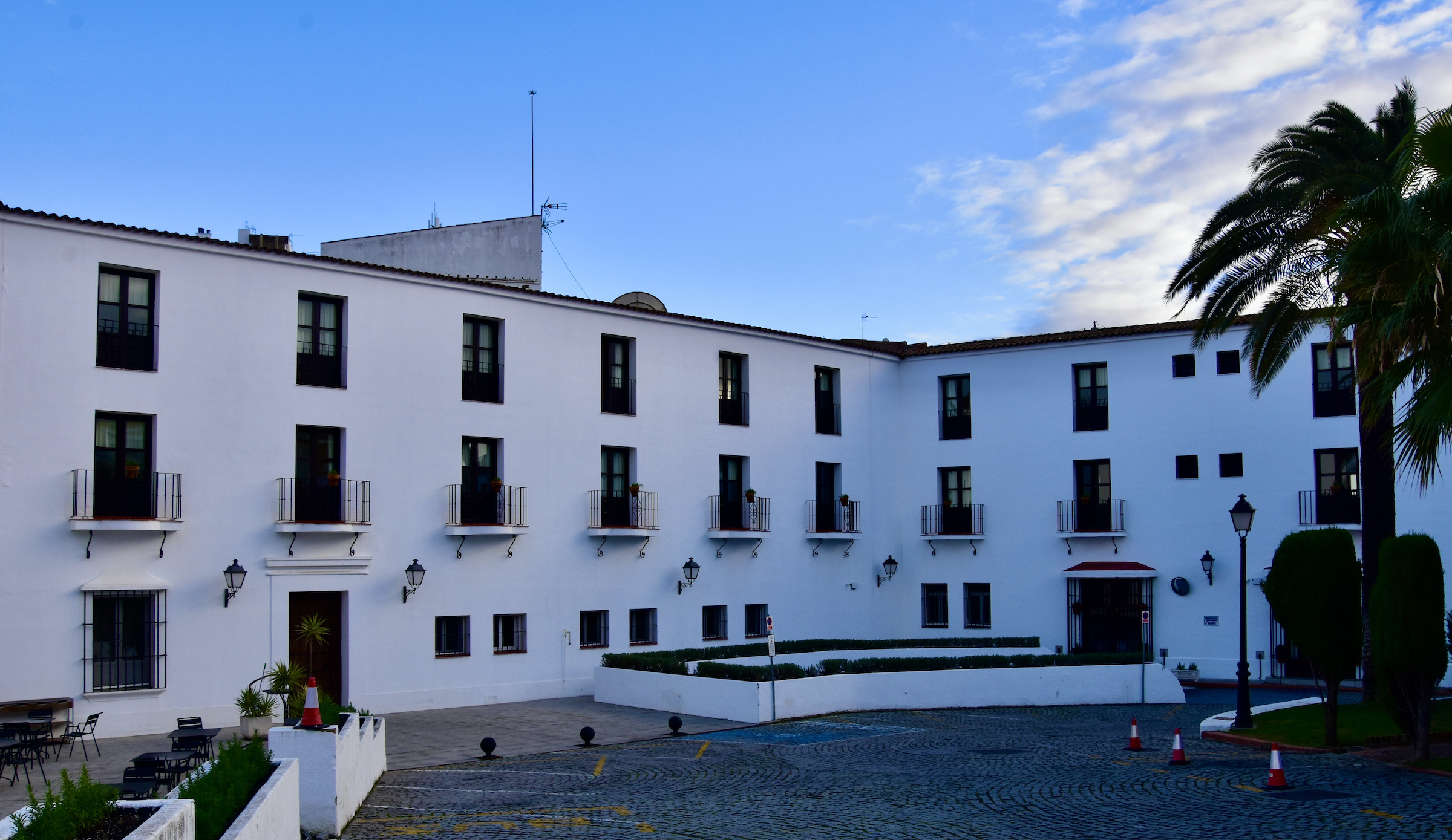
I would be remiss not to mention the perfect place to stay in Merida, the Paradore de Merida which is a former convent which was built atop a Roman temple, remnants of which are found in abundance around and inside the property including the recycled pillars in the courtyard.

Aside from being a fitting place to stay in Merida, the paradore has a really great restaurant that specializes in Extremadura cuisine. How about a cold tomato soup with, I kid you not, sardine ice cream? I have never had a better leg of lamb than that served here and would come back just for that. The breakfast buffet is also outstanding with a great selection of local cheeses and pastries.
- Cold Tomato Soup with Sardine Ice Cream
- Lamb Stew
- Leg of Lamb
- Breakfast Cheeses
This concludes my reasons why if you are a Romanophile, Merida has to be at the top of your list in Spain. In the next post I’ll find out why the Iberico ham of the Extremadura is the best in the world. That should be fun.


